Triangulum Australe constellation lies in the southern sky. Its name means “the southern triangle” in Latin.
The three brightest stars in the constellation form an equilateral triangle. Triangulum Australe was created by the Dutch astronomer Petrus Plancius in the late 16th century and the first depiction of the constellation appeared in 1603, in Johann Bayer’s Uranometria.
The constellation is located too far south to be visible from Europe and most of the northern hemisphere, but it never sets below the horizon south of the equator.
Facts, location and map
Triangulum Australe is the 83rd constellation in size, occupying an area of 110 square degrees. It is located in the third quadrant of the southern hemisphere (SQ3) and can be seen at latitudes between +25° and -90°. The neighboring constellations are Apus, Ara, Circinus and Norma.
The constellation name Triangulum Australe is pronounced /traɪˈæŋɡjʊləm ɔːˈstræliː/. In English, the constellation is known as the Southern Triangle. The genitive form of Triangulum Australe, used in star names, is Trianguli Australis (pronunciation: /traɪˈæŋɡjʊlaɪ ɔːˈstrælɪs/). The three-letter abbreviation, adopted by the International Astronomical Union (IAU) in 1922, is TrA.
Triangulum Australe belongs to the Hercules family of constellations, along with Aquila, Ara, Centaurus, Corona Australis, Corvus, Crater, Crux, Cygnus, Hercules, Hydra, Lupus, Lyra, Ophiuchus, Sagitta, Scutum, Sextans, Serpens and Vulpecula.
Triangulum Australe has one star with a confirmed planet and contains no Messier objects. The brightest star in the constellation is Atria, Alpha Trianguli Australis, with an apparent magnitude of 1.91. There are no meteor showers associated with the constellation.
Triangulum Australe contains one formally named star. The star name approved by the International Astronomical Union (IAU) is Atria.
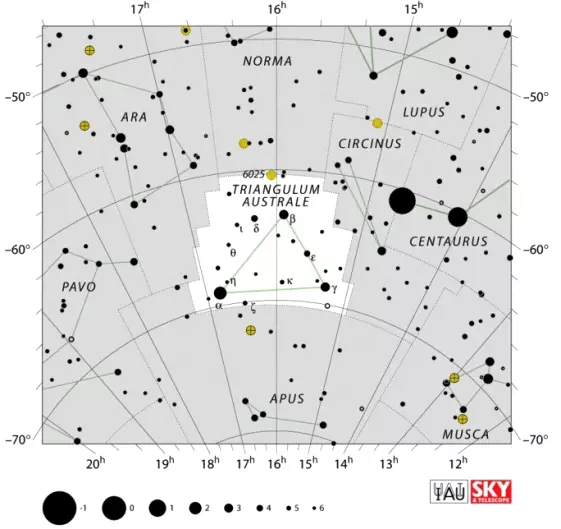
Triangulum Australe constellation map by IAU and Sky&Telescope magazine
Story
Triangulum Australe is not associated with any myths. It is the smallest of the 12 constellations created by the Dutch navigators Frederick de Houtman and Pieter Dirkszoon Keyser in the late 16th century.
The first depiction of the constellation appeared in 1589 on a celestial globe by the Flemish cartographer and astronomer Petrus Plancius, where it was called Triangulus Antarcticus and incorrectly placed to the south of the constellation Argo Navis, which has since been split into three smaller constellations. Johann Bayer gave the constellation the name Triangulum Australe in his Uranometria in 1603.
Nicolas Louis de Lacaille called the constellation “le Triangle Austral ou le Niveau” on his planisphere in 1756 and described it as a surveyor’s level (“niveau”). It was one of the several constellations that represented surveying instruments. The other two were Circinus, the compass, and Norma, the set square.
Johann Bode gave the constellation the alternative name, Libella (the level), in his Uranographia in 1801.
Triangulum Australe stars
Atria – α Trianguli Australis (Alpha Trianguli Australis)
Alpha Trianguli Australis is the brightest star in Triangulum Australe. It has an apparent magnitude of 1.91 and is about 391 light years distant from Earth. Together with Beta and Gamma Trianguli, it forms the triangle asterism after which the constellation got its name.
The star is an orange bright giant with the stellar classification of K2 IIb-IIa. Its estimated age is about 48 million years. It has a mass about 7 times that of the Sun, a diameter 130 times solar, and is 5,500 times more luminous than the Sun. It is a suspected binary star.
The star’s traditional name, Atria, is a contraction of its Bayer designation, A(lpha) Tri(anguli) A(ustralis).
β Trianguli Australis (Beta Trianguli Australis)
Beta Trianguli Australis is the second brightest star in the constellation. It has a visual magnitude of 2.85 and is 40.37 light years distant from the Sun. It is a double star composed of a yellow-white main sequence star belonging to the spectral class F1 V and a 14th magnitude line-of-sight companion separated from the primary by 155 seconds of arc.
The star is showing excess infrared emission, which suggests that it has a circumstellar disk in its orbit.
γ Trianguli Australis (Gamma Trianguli Australis)
Gamma Trianguli Australis is the third brightest star in Triangulum Australe and the third star that forms the triangle asterism that dominates the constellation. It is a white main sequence dwarf belonging to the spectral class A1 V.
It has an apparent magnitude of 2.87 and is approximately 184 light years distant from the solar system. The star has a radius 5.86 times that of the Sun and is a very fast spinner, with a projected rotational velocity of 199 km/s. It is believed to be about 260 million years old. The star is emitting excess infrared radiation, which indicates the presence of a circumstellar disk in its orbit.
δ Trianguli Australis (Delta Trianguli Australis)
Delta Trianguli Australis is the fourth brightest star in the constellation. It is a binary star with an apparent magnitude of 3.86, approximately 621 light years distant from the solar system.
The primary component in the system is a yellow supergiant with the stellar classification of G2Ib-IIa, and the companion is a 12th magnitude star located 30 arc seconds from the primary.
ε Trianguli Australis (Epsilon Trianguli Australis)
Epsilon Trianguli Australis is a wide double star with an apparent magnitude of 4.11. It is approximately 216.1 light years distant from the Sun. The system consists of an orange giant of the spectral type K1-2III and a white main sequence star belonging to the spectral class A5. The primary component has a visual magnitude of 4.11 and the companion, 9.32. The stars are separated by 82.1 seconds of arc.
ζ Trianguli Australis (Zeta Trianguli Australis)
Zeta Trianguli Australis is a spectroscopic binary star with an apparent magnitude of 4.90. It is 39.5 light years distant from the Sun.
The system is composed of a yellow-white dwarf belonging to the spectral class F6 V and a yellow dwarf with the stellar classification of G1 V. The system has a composite stellar classification of F9 V. The two stars have an orbital period of 13 days.
κ Trianguli Australis (Kappa Trianguli Australis)
Kappa Trianguli Australis is a yellow bright giant belonging to the spectral class G5IIa. The star has an apparent magnitude of 5.11 and is approximately 1,207 light years distant from the Sun.
ι Trianguli Australis (Iota Trianguli Australis)
Iota Trianguli Australis is a triple star system in Triangulum Australe. It has an apparent magnitude of 5.28 and is approximately 132 light years distant from the Sun. In a 7.5 cm telescope, the system appears to be composed of a white and yellow star.
The primary star in the system is a spectroscopic binary composed of two yellow-white class F stars. The two stars have an orbital period of 39.8 days. One of the stars is a Gamma Doradus type variable star and, as a result, the system’s brightness varies by 0.12 magnitudes over a period of 1.45 days.
The third star in the Iota Trianguli Australis system is a 10th magnitude star located 20 arc seconds away from the spectroscopic binary.
θ Trianguli Australis (Theta Trianguli Australis)
Theta Trianguli Australis is a yellow giant star belonging to the spectral type G8-K0III. It has a visual magnitude of 5.50 and is 328 light years distant.
X Trianguli Australis
X Trianguli Australis is a red carbon star with the stellar classification of C5.5 (Nb). It has a mean apparent magnitude of 5.63 and is approximately 1,173 light years distant from the solar system. The star is classified as a semi-regular variable with two periods of about 385 and 455 days. Its brightness ranges from magnitude 5.03 to 6.05. The star’s diameter is 400 times that of the Sun. The star has an absolute magnitude of -2.0.
HD 133683
HD 133683 is a yellow-white bright giant star in Triangulum Australe. It belongs to the spectral class F6II. The star has an apparent magnitude of 5.77 and an absolute magnitude of -5.57. It is about 6,037 light years distant.
η Trianguli Australis (Eta Trianguli Australis)
Eta Trianguli Australis is a blue-white subgiant star with the stellar classification of B7IVe. It has an apparent magnitude of 5.89 and is approximately 690 light years distant from Earth.
HD 147018
HD 147018 is a yellow dwarf with the stellar classification of G9V. It has an apparent magnitude of 8.4 and is about 139 light years distant from the solar system. The star has 88 percent of the Sun’s mass.
Two extrasolar planets were discovered orbiting the star in August 2009. The inner planet has a mass at least 2.12 times that of Jupiter and orbits the star with a period of 44.236 days. The outer planet has at least 6.56 Jupiter masses and completes an orbit around the star every 1,008 days.
EK Trianguli Australis
EK Trianguli Australis is a dwarf nova of the SU Ursae Majoris type, characterized by frequent eruptions and occasional supereruptions.
The system is composed of a white dwarf and a donor star. The two orbit around a common centre of gravity with a period of 1.5 hours. The white dwarf draws matter from the donor star onto an accretion disk and occasionally erupts. The star normally has an apparent magnitude of 16.7 and reaches 12.1 in normal outbursts. During the superoutbursts, the star’s brightness increases by 0.24 magnitude for 1.55 hours.
EK Trianguli Australis is at least 586 light years distant from the solar system.
Deep sky objects in Triangulum Australe
ESO 69-6
ESO 69-6 is a pair of galaxies that are currently in the process of colliding and merging with each other. The galaxies are approximately 600 million light years distant from the solar system.
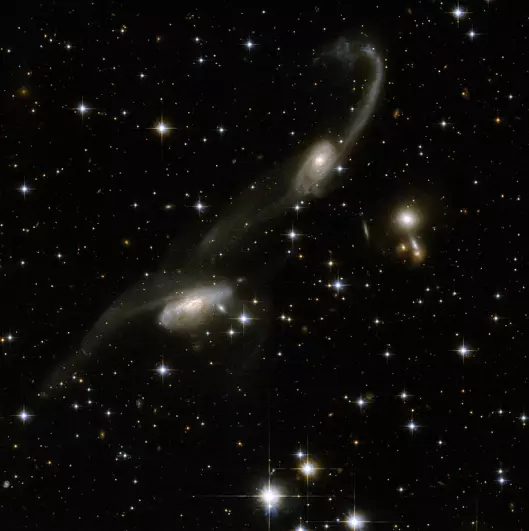
ESO 69-6 – The galaxies of this beautiful interacting pair bear some resemblance to musical notes on a stave. Long tidal tails sweep out from the two galaxies: gas and stars were stripped out and torn away from the outer regions of the galaxies. The presence of these tails is the unique signature of an interaction. ESO 69-6 is located in the constellation of Triangulum Australe, the Southern Triangle, about 650 million light-years away from Earth. Image: NASA, ESA, the Hubble Heritage (STScI, AURA)-ESA, Hubble Collaboration, and A. Evans (University of Virginia, Charlottesville, NRAO, Stony Brook University)
NGC 6025
NGC 6025 is an open cluster with an apparent magnitude of 5.1. It is approximately 2.700 light years distant from the solar system. The cluster was discovered by the French astronomer Nicolas Louis de Lacaille in 1751-1752 while he was mapping the southern skies in South Africa.
NGC 5938
NGC 5938 is a spiral galaxy approximately 300 million light years from Earth. It lies 5 degrees to the south of the star Epsilon Trianguli Australis.
ESO 137-001
ESO 137-001 is a barred spiral galaxy in Triangulum Australe. It is located in the Norma Cluster (Abell 3627) which lies in Triangulum Australe and Norma constellations. The galaxy is notable for its long tail, stretching across 260,000 light years.
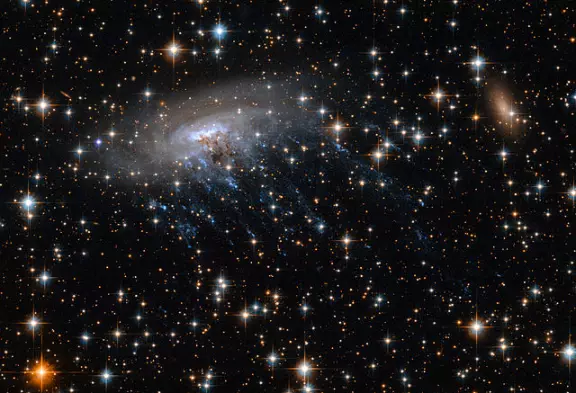
This new Hubble image shows spiral galaxy ESO 137-001, framed against a bright background as it moves through the heart of galaxy cluster Abell 3627. This image not only captures the galaxy and its backdrop in stunning detail, but also something more dramatic — intense blue streaks streaming outwards from the galaxy, seen shining brightly in ultraviolet light. Image: NASA, ESA; acknowledgements: Ming Sun (UAH), and Serge Meunier
NGC 5979
NGC 5979 is a planetary nebula in Triangulum Australe. It has an apparent magnitude of 12.3.
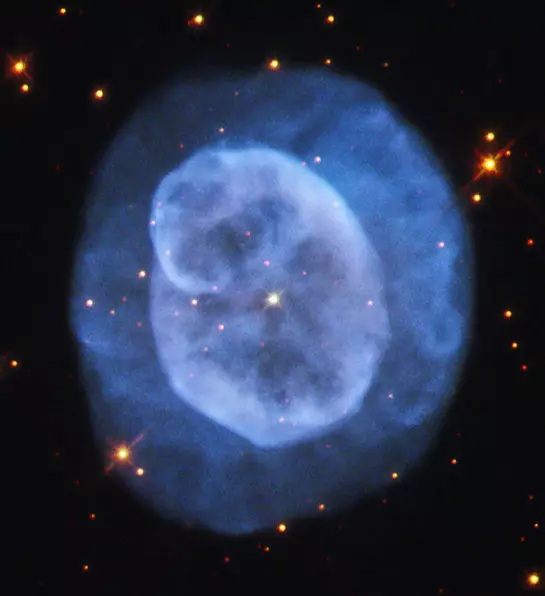
NGC 5979, image: Judy Schmidt (CC BY 2.0)
Henize 2-138
Henize 2-138 is another planetary nebula, smaller in size than NGC 5979. It has a visual magnitude of 11.0.
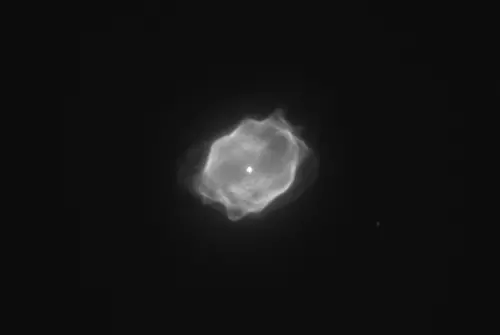
Henize 2-138, image: Solomon Hendrix (CC BY 2.0)